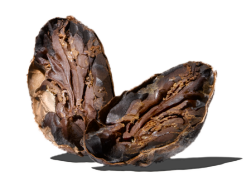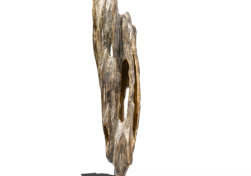When hip stylist Camille Bidault Waddington was photographed in her home for French Vogue, she chose to be shot alongside just a few of her favorite things: an antique wooden dresser, a sensuous sculpture and a vase overflowing with bulbous pom-poms of inky-blue hydrangeas. In the past, the hydrangea was a plant that was kept strictly outside. Today, it’s the bloom du jour, not just for stylists, but couturiers, jewellers, hoteliers – and even milliners. At last year’s Kentucky Derby, the heads of fashionable women were adorned with it, clearly inspired by such great hat-makers as Paulette Marchand, who created “caps” of hydrangea blossom for such clients as Greta Garbo and Edith Piaf. “Hydrangeas just go anywhere,” says florist Reed McIlvaine, whose arrangements adorn The St. Regis New York. “In winter we use big white balls of them to recreate snowy scenes, and in fall use them to turn the lobby into a jewelbox of beautiful rich antique colors. They’re incredibly versatile.” rennyandreed.com
Category Archive: 7 objects
Just as men today might compare watches or cars, in 17th-century China the object of desire was a snuff bottle. According to dealer Robert Hall, these miniature bottles were not just objects in which to carry powdered tobacco, but intricately embellished masterpieces, created for China’s elite. Snuff bottles only came to popularity in China because of a ban on smoking tobacco by the rulers of the Qing Dynasty. A bottle that was both portable and watertight became the ultimate vanity object, and exquisite models were created by master craftsmen in materials from porcelain, jade, ivory and coral to wood and glass. Today hundreds of the tiny treasures still make their way into collectors’ hands through organizations such as the Baltimore-based International Chinese Snuff Bottle Society. Their value, too, has soared. In 2010, Bonham’s received one of the biggest ever collections, of 1,700 bottles, which it valued at more than $47m, and in 2011, a bottle delicately painted with a Chinese landscape was sold for a record-breaking $4.17m. e-yaji.com; snuffbottle.com
While many horologists obsess about the movement and complications housed within a watch’s casing, for most watch-lovers, it is the look of a watch that matters most. Hence the trend in the past few years for watch manufacturers to invent increasingly decorative dials. Vacheron Constantin, the world’s oldest watch brand, has led the way by creating what are considered some of the most elaborate and intricate watches ever made. Each of its Métiers d’art collection is not just decorated with a different and highly complicated pattern, but layered with enamel, engraved by master craftsmen and then hand-painted by fine artists. Although the trend for decorative watches is gaining momentum, it dates back more than 500 years to when watches were made using mostly brass or copper and the dials enamelled to make them look more luxurious. In the 21st century, just as in the Middle Ages, designers have realized that, while complications are beloved by aficionados, the one thing no watch-lover can resist is a pretty face. vacheron-constantin.com
For those who didn’t know that wooden surfboards were having a moment, there is plenty of proof online. Such is the devotion of the natural board’s fans that there are now more than 120 websites dedicated to their manufacture. Once the means by which islanders would sail between atolls in the South Seas, wooden boards have become not just the most coveted of surfing equipment, but the most expensive. Master craftsman Roy Stuart recently made the ultimate luxury board, the $1.3m Rampant, its surface hand-painted in gold leaf and finely skimmed in Paulownia. This Asian wood was relatively unknown by surfboard makers until it was used in Australia in the 1980s by the American board-shaper Tom Wegener, who has subsequently become its greatest supporter. Not only is the Asian wood lighter than balsa, it is also more resistant to salt water than any other wood. Today, inspired by the ancient alaia boards in Hawaii’s Bishop Museum – often more than six feet long, finless and only half an inch thick – Wegener has created the finest, lightest waveriders ever created. driftwoodsurfboards.co.uk
One might have imagined that the postcard would have died a death in the internet age. But there’s a growing trend for cool types to send “retro” postcards, according to Katherine Hamilton-Smith, director of cultural services at the Lake County Discovery Museum in Chicago, which holds the Curt Teich Postcard Archives, the world’s largest public collection of postcards. Cards have become collectable: the work of John Hinde’s studio is highly sought after, as are works by historic postcard artists such as New York-born Ellen Clapsaddle and Australia’s Ida Outhwaite. Far from destroying the postcard, the internet has attempted to emulate its essence. The first
e-postcard site, The Electric Postcard, was created in 1994 at the MIT Media Lab, and since then apps such as Postcard on the Run and Postagram have been invented that convert messages into physical cards. But even with this innovative technology, old-fashioned postcards will never die out, says Hamilton-Smith. “They’re both
a tiny physical gift and a message; evidence that someone somewhere is thinking of you.” teicharchives.org
Istanbul is crammed with colorful shops vying for attention. But the emporia that really snag the eye are those selling pyramids of gelatinous cubes in acidic greens, pinks and reds, dusted with icing sugar. More than mere candy, this Turkish Delight or lokum is a visual and toothsome feast, in a riot of flavors such as rosewater, cherry, orange and apricot, with delicious additions such as cinnamon, ginger and nuts. Today the sweet is also gaining respect from leading restaurants and shops around the world. Most notable is Zeynep Keyman’s Lokum Istanbul store, designed by interiors guru Anouska Hempel. Keyman aims to revive lokum in fashionable circles by placing it in chic boxes adorned with Ottoman Toile de Jouy and fez-like tassels. Basic lokum is made from water, sugar, a stiffening agent, floral ingredients such as rosewater, and flavors ranging from fig to pomegranate. One can see why C.S. Lewis, in The Chronicles of Narnia, chose Turkish delight as the White Witch’s lure for poor Edmund. It is the perfect perfumed temptation. lokumistanbul.com
To the ancient civilisations of the Maya and the Aztecs, it was a highly prized currency; now the humble cocoa bean is once again revered in the kitchens of Michelin-starred restaurants. Philipp Kauffmann, co-founder of the sustainable chocolate company Original Beans, has a passion for the world’s rainforests and a hard head for business. Not only has he helped stimulate and support sustainable livelihoods from Peru to Africa, he has also created a premium organic product that has won the admiration of chefs. For every bar of chocolate purchased, Original Beans plants a tree in the forest of its origin and pays producers up to six times the Fair Trade rate, ensuring that the economic benefits are passed all the way back to source. The Original Beans Cru Virunga dark chocolate from the Congo, described as “zingy with ripe morello cherries steeped in cassis, smoky tobacco and forest-floor notes” is made from just three ingredients: organic cocoa beans, cocoa butter and organic cane sugar. What it becomes after that is up to the skill and imagination of the world’s finest chefs. originalbeans.com
Although it has been used for centuries in the Middle East, until about ten years ago oud was almost unknown as an ingredient in Western perfumery. In Arabia, the sweet, rich scent is an important part of the culture. The resin of the agar tree is instilled into precious perfumes, and the tiny chips of agar are burnt to create a sweet smoke to fragrance homes, clothing and mosques. Due to its rarity, and the difficulty of harvesting the resin, oud costs about one-and-a-half times the price of gold – about 150lb of wood yields just five teaspoons of essential oil – and a kilo of oud costs upwards of $70,000. Roja Dove – the British custom perfumer – loved the scent so much that he launched three oud perfumes under his name. Why? “Oud is the smell of Arabia in a bottle,” he explains. “It reminds me of the people I met there and of the emotions inspired by the beauty of the landscape. For me, it’s ancient, it’s natural and incredibly heady. What more could you want of a fragrance?” rojadove.com
Like car manufacturers or yacht engineers, high-end watchmakers thrive on achieving ever-more mind-boggling feats of engineering. Except that in watchmaking it is on a micro scale. The skill of these (mainly Swiss) technicians is their ability to keep mechanisms small and light while improving the watches’ functionality; this they do by creating “complications”, or additional mechanical layers. The most complex of all of these complications is the tourbillon, invented by an Englishman to counter the effects of gravity on timekeeping accuracy and developed and patented by Abraham-Louis Breguet in 1801. Nothing is quite so desirable as a watch with a tourbillon. Why? Because the more complicated a watch, the harder it is to make and the fewer there are produced. The Breguet Messidor Tourbillon, costs $180,000. “An array of meticulously finished parts lovingly polished, chamfered, chased and scored with parallel decorative strokes by the most versatile of all instruments, the human hand.” breguet.com
Some of the finest cashmere, as lovers of the fabric will attest, is woven in Scotland. It is in the Scottish Borders region adjoining England, beside the clear streams, that a Scot, Joseph Dawson, invented a mechanical process to sort and clean the fibres in the 19th century, and it is here, ever since, that designers have had their clothing produced. The hair itself comes from the Mongolian goat, which lives in sub-zero temperatures at high altitudes in the mountains of Mongolia, China, Tibet and the Himalayan region of Kashmir. It is only, as James Sugden of Johnstons of Elgin explains, when the fiber is washed in Scottish spring water, hand-spun, then colored using the finest-quality non-harmful dyes, that the very finest cashmere becomes ultra-soft. “You can feel the difference between something that has been produced in Scotland and elsewhere,” he says. “Cashmere is ruined by corrosive dyes and chemicalized water. ‘Made in Scotland’ is reassurance that that fiber has been treated in the best way possible.” johnstonscashmere.com









